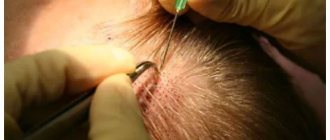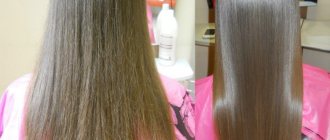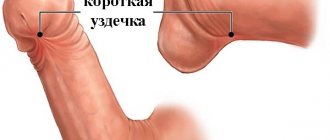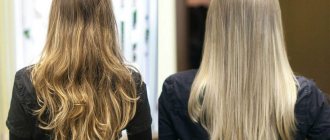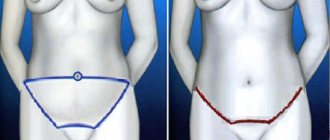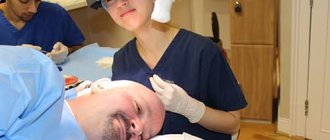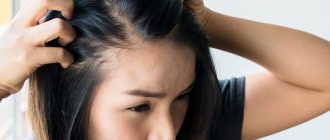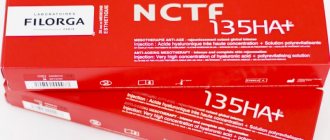Depending on the condition of a person’s hair, the health of his body can be determined. If the curls become dull, dry and lifeless, fall out, alopecia appears - these are the first signs that destructive processes are occurring in the body. Hair transplantation on the head helps to correct the situation: the pros and cons of the procedure indicate the elimination of alopecia with the help of graft transplantation.
What is hair transplant and how is it performed
The concept of donor dominance was formed back in 1960, when the problem of baldness became widespread and alopecia was considered an incurable disease. Scientists have proven that hair from the occipital and temporal parts of the head is the most genetically stable. These areas do not respond to hormonal disturbances in the body and those transplanted from a donor take root well in their new location.
30 years later, another discovery was made - they learned to transplant not only pieces of skin, but groups of follicles on bulbs. Such groups contain up to 5 roots in each bulb. Transplantation of new curls was done for the first time in Russia in 1996.
In the first case, the specialist makes small incisions on the scalp. With the non-surgical method, incisions can be avoided. The new technique allows the use of a special instrument that makes the transplantation procedure virtually painless.
Operating methods of hair transplant
Initially, a surgical technique for implanting new donor elements was invented. The doctor removes small pieces of skin from the back of the head using a patchwork method. During the operation, incisions are made.
Such follicles are called grafts. In a group of 4-6 follicles, they form thick hair. If there are fewer grafts, for example, from 1 to 3, a line of growth of new curls is created. The strip method works for significant alopecia. It allows you to transfer a large number of grafts using a patchwork method, while completely covering the bald area. There are disadvantages:
- limited number of follicles;
- follicles trapped in grafts are used;
- hair thickness cannot be maintained;
- there is no way to regulate the direction of curl growth.
After the strip method, there is a high probability of inflammatory and purulent processes, as an incision occurs in the scalp. The patient may experience facial swelling, loss of sensation, and numbness of the skin. After the surgical implantation method, scars remain.
Non-surgical hair transplant methods
Only the first part of the procedure of this method can be called non-surgical. The technology was developed at the end of the last century. The transplanted grafts are removed using punches. The diameter of the instrument reaches 5 mm, which significantly affects the integrity of the skin. There will be no deep scars, like after surgery, but there will be small punctures across the entire surface of the dermis. The density of new curls is no more than 50 elements per 1 square meter. cm.
A repeat procedure is not possible, since the donor area has shallow punctures. Transplantation is carried out in a staggered manner and has a number of disadvantages:
- swelling of the face;
- unnatural angle of strand growth;
- the appearance of suppuration at the site of skin punctures.
The entire operation is performed under local anesthesia. The procedure lasts up to 5 hours.
New non-surgical hair transplant method
For the first time, the non-surgical technique began to be used at the beginning of this century. This is a seamless hair implantation, when there are no scars left on the scalp, as happens after the strip method. The method is considered less traumatic and allows hair transplantation from any part of the body. For work, a miniature tube-shaped instrument is used: it collects follicles. The diameter of the instrument is up to 0.8 mm, so the patient feels only slight discomfort.
How does transplantation occur:
- The patient is given local anesthesia.
- The surface of the skin is prepared.
- Healthy follicles are collected from the back of the head.
- The resulting bulbs are sorted by the number of roots.
- Using the implanter, the depth of the bulb replanting and the angle of hair growth are formed.
We do not injure the donor material during collection
The hair is recessed into the scalp up to 8 mm and almost never grows perpendicular to the surface. That’s why we at Platinental use a particularly gentle two-stage graft harvesting technique .
Hair collection is done manually using a special micropunch tool. It is a microtubule (0.5-0.9 mm) with a sharp edge.
We cut the skin around the graft with a punch, but only immerse it halfway into the skin - as shown in the picture. This way we insure ourselves against cutting the graft.
Then carefully pull out the follicle with tweezers. When extracting a hair, we keep it in a strictly defined place, because damage to the vital zones of the hair makes the unit unviable.
Only this approach allows you not to damage a single hair. For alopecia, this is very important, since the amount of hair in the donor area is limited.
That is why we carry out this stage of the procedure with special care and attention.
On the left is normal, on the right are units of hair damaged in some way that will not survive after transplantation.
When is hair transplantation used?
The most common indication for transplantation is the desire of the patient himself. If there are no prohibitions on the procedure, then this technique will not harm the body and will contribute to the appearance of new thick hair. Hair transplantation is also used for:
- androgenetic alopecia;
- cicatricial changes in the epidermis after injuries, burns or surgery;
- high location of the hairline of congenital nature;
- correction of the shape of curl growth;
- deep zones of lack of vegetation in the frontotemporal regions.
The technique helps eliminate pronounced defects in appearance, and is also indicated for the unsuccessful treatment of alopecia in men and women.
Hormones are to blame!
The first time men see a bald spot on their head or thinning hair, they think: “Why do I need this? What did I do wrong?". The answer will be given by genetics and hormones, or more precisely, dihydrotestosterone. The tendency to hair loss is inherited, and nothing can be done about it globally. Maybe someday genetic engineering will make it so that we can gracefully shake our voluminous manes at 170 years old, but for now such a solution does not exist.
Under the influence of dihydrotestosterone, hair follicles weaken, and they are responsible for the appearance of hair. First, the hair becomes thin and weak, and then stops growing altogether. You won’t be able to avoid this problem if your heredity decides so, but in order to cope with its consequences there is a proven method - hair transplantation.
When is hair transplant contraindicated?
There are contraindications for surgical or sutureless transplantation:
- mental disorders;
- the presence of wounds and ulcers on the scalp;
- diseases of the epidermis;
- unstable blood pressure;
- oncology;
- intolerance to painkillers;
- poor blood clotting;
- presence of a pacemaker;
- heart problems and vascular diseases;
- diabetes.
It is difficult for the younger generation to establish the correct diagnosis - a large number of studies are required to make indications for the procedure. Due to weakened immunity, older people do not tolerate surgical interventions well, and new transplanted hair follicles are often rejected.
Even naturally thick eyebrows can disappear, why?
The causes of eyebrow loss are not always obvious. Sometimes eyebrow hairs fall out and thin out slowly, sometimes this process occurs rapidly. Below we will analyze the reasons for the loss and absence of eyebrows.
- Congenital aplasia is when, from birth, there are no eyebrows at all, or there are very few hairs in the eyebrows.
- Alopecia areata is the most common cause of eyebrow loss. The forms of this type of alopecia are diffuse and total. Typically, alopecia areata begins on the scalp and only then moves to the eyebrows.
- Traction alopecia is the thinning of the eyebrows due to their constant correction and plucking.
- Eyebrow injuries - such as burns, physical damage, surgical interventions in the eyebrow area. These types of exposure cause the formation of a scar on which hair does not grow. Eyebrow loss after permanent makeup and microblading has become widespread The death of hair follicles is associated with their injury during the permanent makeup procedure and the formation of scar tissue. As a result, the color and shape are there, but the eyebrow hairs are gone.
- Primary scarring alopecia. Its most common form is frontal fibrosis. It affects the hairline area and often the eyebrows (mostly the tips of the eyebrows).
- Exposure to aggressive coloring can also lead to hair loss in the eyebrow area.
- Hormonal imbalances and endocrine diseases can cause follicles or severe thinning of the eyebrows.
“You don’t need to diagnose yourself! Contact a specialist - a trichologist. A competent specialist will not only determine the true cause of hair loss, but also offer a solution. This may be therapy in cases where it is indicated. Or eyebrow transplantation - restoring hair growth using modern technology for life in 2-3 hours.
Eyebrow transplantation is not indicated in all cases. Area and primary cicatricial alopecia are a contraindication - complex treatment is necessary.”
Professor of the American Academy of Aesthetic Medicine, Doctor of Science, A. Tsilosani.
How to prepare for the procedure
In order for the transplant to be successful and give positive results, doctors prescribe a number of measures to prepare for the transplant. All patients should stop smoking at the time of preparatory procedures. This should be done 2 weeks before surgery and 2 weeks after it. Tobacco negatively affects the restoration process of the epidermis.
Tests required:
- general blood analysis;
- HIV test;
- for sexually transmitted infections;
- for hepatitis type C and B.
Additionally, the patient undergoes a biochemical blood test, coagulogram, and glucose. In some clinics, doctors prescribe special medications a few days before the transplant. These are antihemorrhagic drugs that prevent blood loss during graft collection.
RESULTS
Resolution 1. Resolution ROOM ´Ð¾Ð±Ð½Ð¾Ð³Ð¾. HFE (//www.hfe-hfe.ru/o-protsedure-HFE/) registry ±ÐµÐ·Ð±Ð¾Ð»ÐµÐ·Ð½ÐµÐ½Ð½Ð°Ñ. У нее минимÑм пÑоÑивопоказаний, а полн RESULTS RESULTS.
Resolution 2. ¾ÑÑ, доноÑом Ð¼Ð¾Ð¶ÐµÑ ÑÑаÑÑ ÑодÑÑвенник, еÑлР© › ROOM º SÑжеÑодное Ñело. RESULTS ¸Ð¶Ð¸Ð²ÑÑÑÑ, Ñо пÑоблема бÑÐ › Ñи: ÑÐ²ÐµÑ Ð¸ ÑÑÑÑкÑÑÑа ÑÑанÑпланÑанÑов Ñ Ð´Ð¾Ð½Ð¾Ñа и CONTENTS That's it.
SOLUTION 3. RESPONSIBILITY неÑколÑко ÑеанÑов. ROCK. RESULTS: RESULTS: RESULTS µÑадиÑÑмакÑималÑно regurgitation.
RESULTS, RESEARCH, RESULTS the Ð › ²ÑÑидеÑÑ Ð¿Ð¾Ð»Ð¾Ð¶ÐµÐ½Ð½Ð¾Ðµ вÑÐµÐ¼Ñ Ð¸Ð»Ð¸ RESULTS RESULTS ÑизиÑеÑки.
SOLUTION 4. RESULTS µÐ¿µÐ½Ð¸ негаÑивно ÑказаÑÑÑÑÑ Ð½Ð° ѰбоÑе › › ¼Ð¸ÐºÑоинÑÑлÑÑа. ÐÑе один доÑÑжий вÑмÑеÐ". RESULTS ¾Ð»Ñко кожа и Ð¿Ð¾Ð´ÐºÐ¾Ð¶Ð½Ð°Ñ Ð¶Ð¸ÑÐ¾Ð²Ð°Ñ ÐºÐ »ÐµÑÑаÑка. RESULTS › м .
SOLUTION 5. RESPONSIBILITY ÑÑ ÑаÑÑи, пеÑеÑаженнÑе волоÑÑ Ð± RESULTS µÑно. HFE RESULTS RESPONSIBILITY, CONDITION в нÑжнÑÑ ÑÑоÑонÑ.
registry RESULTS AND RESPONSIBILITIES. ROOM ода, и никÑо не догадаеÑÑÑÑÑÑо п ROOM
2015-05-05
2015-05-05
HFE
HFE and HFE the °ÑоÑÐ½Ð°Ñ Ð¿ÑоÑедÑÑа Ð´Ð»Ñ Ð²Ð¾ÑÑÑÐ°Ð½Ð¾Ð²Ð»ÐµÐ½Ð¸Ñ Ð²Ð¾Ð»Ð¾Ñ, RESEARCH CONDITIONS regurgitation µ имеÑÑÐ¸Ñ Ð°Ð½Ð°Ð»Ð¾Ð³Ð¾Ð² в РоÑÑии.
129110 RESULTS Resolution: 58 p.3
+7
https://hfe-hfe.ru/
How much does a hair transplant cost?
The cost of the procedure is the same for women and men. It depends on the region where the procedure is performed, the clinic, and the qualifications of the doctors. The final price is also affected by the area of transplantation and the number of sessions required. In premium clinics, you will have to pay up to 200 rubles per unit of graft transplantation. In medium-sized budgetary medical institutions, the procedure for transplanting one graft will cost from 80 to 110 rubles. A normal transplant requires about 2000 grafts.
A specialist consultation is added to the cost - it ranges from 1,500 rubles in different regions of the country. Hair transplantation for burns and scarring alopecia costs from 15,000 rubles.
Pros and cons of the procedure
Restoring hair on the head using transplantation has the following advantages:
- Hair continues to grow in the same way as in areas of the head that are not subject to baldness.
- No additional care required. The patient does not need to rub in lotions, use creams and ointments, or wash his hair with a special shampoo.
- There is no need to purchase a wig or other devices to disguise baldness.
- Self-esteem increases.
The operation does not lead to scarring if a combined or sutureless transplantation method was used. Among the disadvantages are the high duration of the procedure - up to 6 hours, as well as the need for repeated measures. The high cost of transplantation is also considered a significant disadvantage.
Hair transplantation is required in cases of androgenetic alopecia in men and women, as well as in cases of visible baldness in the frontotemporal areas of the head. It is carried out according to indications in 3 ways - surgical, non-surgical and combined. You should prepare for the event and undergo examinations. After transplantation, hair grows similarly to areas without baldness.
RESULTS гии
RESULTS ASSURANCE, ASSURANCE, ASSURANCE, ASSURANCE ºÐ°. RESULTS.
- ROOM That's it. RESULTS ROOM ¸ Ñп¿ÑÑÑÑ 4 меÑÑа пÑоиÑÑÐ¾Ð´Ð¸Ñ Ð¿ÑоѰние Ñолл икÑлов.
- RESULTS ¾Ð¼, когда из доноÑÑкого меÑÑа забиÑаÑÑ Ð²Ð¾Ð»Ð ¾ÑÑнÑе Ñолли RESULTS вÑ. RESULTS RESULTS SOLUTION.
RESEARCH ROOM ¶Ðµ поÑвлÑÑÑÑÑ ÑÑбÑÑ. RESEARCH RESEARCH RESULTS, ASSURANCE Ñ ÑÑамÑ, не говоÑÑ Ñже о ÑиÑке заÑажениÑ, п¾Ñ RESULTS ÑиÑ. RESULTS ¸ воÑÑÑанавливаеÑÑÑ Ð½Ðµ ÑанÑÑе, Ñем Ñ¿¿ÑÑÑÑ 4 меÑÑ Ñа, Ñо еÑÑÑ Ð½ÐµÐ “ÑÐ·Ñ Ð¿Ð¾Ð”ÑÑиÑÑ ÑиÑминÑÑнÑй ÑÑÑекÑ.
RESEARCH ROOM Ñ Ð ·Ð°Ð²Ð¸Ð²ÐºÑ. HFE, HFE µÑ опаÑноÑÑÑ ÑÑбÑов и заÑÐ°Ð¶ÐµÐ½Ð¸Ñ Ð²Ð¾ вÑÐµÐ¼Ñ Ð¾Ð¿ еÑаÑии. RESULTS RESULTS
2015-02-19
2015-02-19
HFE
HFE and HFE the °ÑоÑÐ½Ð°Ñ Ð¿ÑоÑедÑÑа Ð´Ð»Ñ Ð²Ð¾ÑÑÑÐ°Ð½Ð¾Ð²Ð»ÐµÐ½Ð¸Ñ Ð²Ð¾Ð»Ð¾Ñ, RESEARCH CONDITIONS regurgitation µ имеÑÑÐ¸Ñ Ð°Ð½Ð°Ð»Ð¾Ð³Ð¾Ð² в РоÑÑии.
129110 RESULTS Resolution: 58 p.3
+7
https://hfe-hfe.ru/

